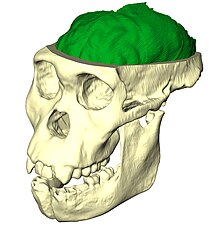
Back Paleoneurologie Czech Paläoneurologie German Paléoneurologie French Paleoneurobiologia Italian 고생물신경학 Korean Paleoneurologie Dutch Paleoneurobiologia Portuguese Палеоневрология Russian Палеоневрологія Ukrainian

| Part of a series on |
| Paleontology |
|---|
 |
|
Paleontology Portal Category |
Paleoneurobiology is the study of brain evolution by analysis of brain endocasts to determine endocranial traits and volumes. Considered a subdivision of neuroscience, paleoneurobiology combines techniques from other fields of study including paleontology and archaeology. It reveals specific insight concerning human evolution. The cranium is unique in that it grows in response to the growth of brain tissue rather than genetic guidance, as is the case with bones that support movement. Fossil skulls and their endocasts can be compared to each other, to the skulls and fossils of recently deceased individuals, and even compared to those of other species to make inferences about functional anatomy, physiology and phylogeny. Paleoneurobiology is in large part influenced by developments in neuroscience as a whole; without substantial knowledge about current functionality, it would be impossible to make inferences about the functionality of ancient brains.[1]
Hominid paleoneurobiology refers specifically to the study of brain evolution by directly examining the fossil record of humans and their closest hominid relatives (defined as species more closely related to humans than chimpanzees).[2] Paleoneurobiologists analyze endocasts that reproduce details of the external morphology of brains that have been imprinted on the internal surfaces of skulls.[3]
- ^ Bruner, Emiliano (2003). "Fossil traces of the human thought: paleoneurobiology and the evolution of the genus Homo" (PDF). Journal of Anthropologia Sciences. 81: 29–56. Archived from the original (PDF) on 2012-04-26. Retrieved 2011-12-01.
- ^ Bienvenu, Thibaud; Guy, Franck; Coudyzer, Walter; Gillissen, Emmanuel; Roualdes, Georges; Vignaud, Patrick; Brunet, Michel (2011). "Assessing endocranial variations in great apes and humans using 3D data from virtual endocasts" (PDF). American Journal of Physical Anthropology. 145 (2): 231–236. doi:10.1002/ajpa.21488. PMID 21365614.
- ^ Falk, Dean (1987). "Hominid Paleoneurobiology". Annual Review of Anthropology. 16: 13–30. doi:10.1146/annurev.an.16.100187.000305. JSTOR 2155862.
© MMXXIII Rich X Search. We shall prevail. All rights reserved. Rich X Search